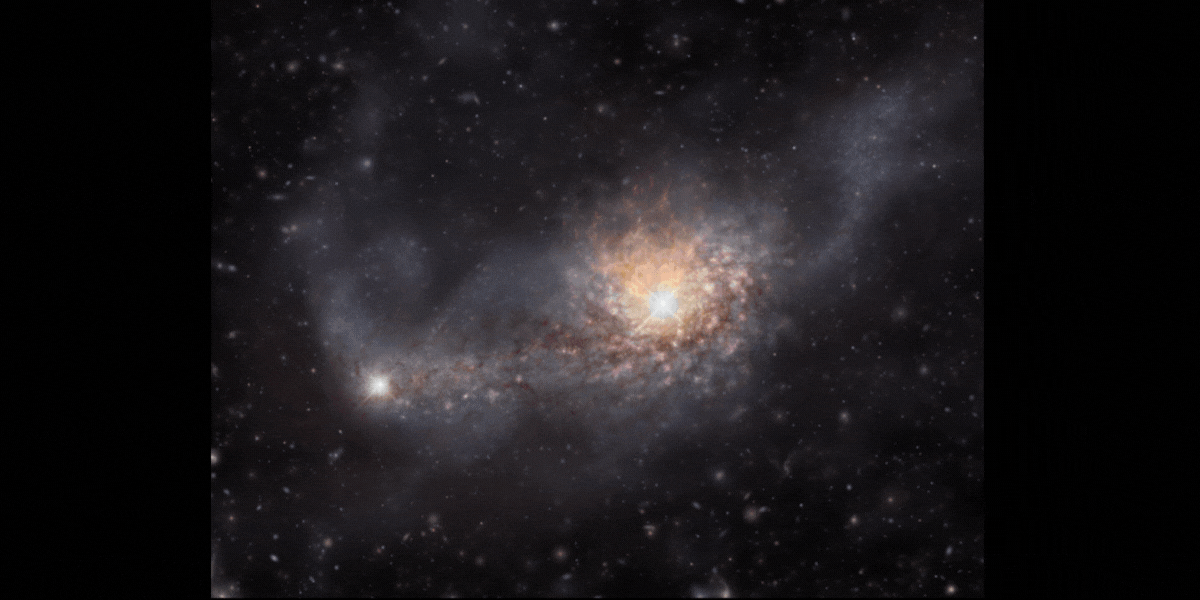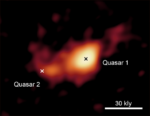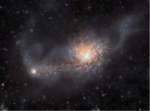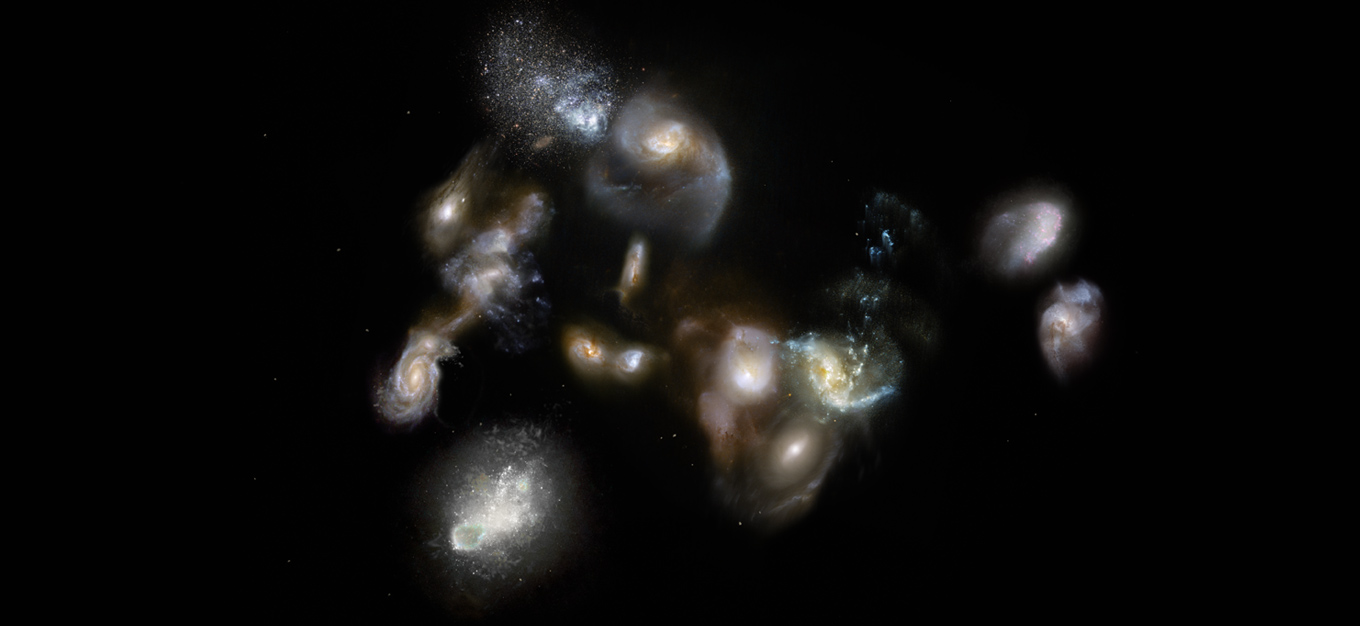Dancing Galaxies Make a Monster at the Cosmic Dawn
Using the combined power of the Subaru Telescope and the ALMA radio telescope, astronomers have discovered a system where two distant galaxies, located 12.8 billion light-years away, are in the process of merging. These galaxies, hosting faint quasars at their centers, could be the ancestors of the brightest and most massive quasars in the early Universe, shedding light on the mysterious processes that trigger the explosive growth of supermassive black holes.
Astronomical observations to date have discovered several supermassive black holes with masses exceeding a billion times that of the Sun in the early Universe when it was less than a billion years old. These objects, known as high-luminosity quasars, shine brighter than an entire galaxy when they consume vast amounts of interstellar matter. Galaxies hosting these quasars often experience a burst of star formation, producing hundreds to thousands of times the mass of our Sun in new stars every year. What triggers and sustains such rapid growth of supermassive black holes and starburst activity?
A leading hypothesis is the mergers of gas-rich galaxies. Scientists think that when gas-rich galaxies merge, some of the gas gets compressed to form a large number of stars, while some of it flows into the galaxy's center, fueling the growth of the central black hole. To better understand galaxy/black hole formation in the early Universe, we need detailed investigations of the probable ancestors of high-luminosity quasars: galaxies and black holes in the pre-merger stage. However, research on such ancestors has long been stagnant because they are not yet bright, high-luminosity quasars (before merging), making them extraordinarily faint and difficult to detect.
To overcome this challenge, a research team led by Associate Professor Yoshiki Matsuoka of Ehime University analyzed large-scale survey data taken with the Subaru Telescope's Hyper Suprime-Cam, which boasts a vast field of view. Utilizing the Subaru Telescope's high light-gathering power, this survey is significantly more sensitive than other large-scale surveys, enabling astronomers to detect fainter objects. As a result, the team discovered a system with two very faint quasars (about 10 to 100 times fainter than high-luminosity quasars of the same era) side by side.
Located approximately 12.8 billion light-years away, corresponding to the "Cosmic Dawn" era when the Universe was only 900 million years old, this is the most distant record of such "pair quasars." Due to their faintness, scientists thought these objects were in the pre-merger stage before the rapid growth of the supermassive black holes. However, observations with the Subaru Telescope could only provide information about the central supermassive black holes, leaving unanswered whether the host galaxies were destined to merge and eventually grow into high-luminosity quasars.
As a next step, a research team led by Associate Professor Takuma Izumi of the National Astronomical Observatory of Japan conducted observations of the host galaxies of these pair quasars using the ALMA radio telescope. The results obtained during Director's Discretionary Time were astonishing. The distribution of interstellar matter observed (two host galaxies and the structure bridging them: Figure 1) and the nature of their motion indicated that these galaxies were interacting. They are undoubtedly on the path to merging into a single galaxy shortly. Furthermore, calculations from the observational data revealed that the total gas mass in these galaxies (around 100 billion times the mass of the Sun) is comparable to or even more significant than the gas masses of the host galaxies of most high-luminosity quasars, whose nuclei are extraordinarily bright. With this tremendous amount of material, post-merger explosive star formation and fueling of the supermassive black holes should be easily triggered and sustained. Therefore, these findings represent a significant achievement in identifying the ancestors of high-luminosity quasars—the brightest celestial objects in the early Universe—and starburst galaxies from multiple perspectives, including galaxy structure, motion, and the amount of interstellar matter.
Commenting on this discovery, Associate Professor Takuma Izumi, who led the research, expresses his excitement: "When we first observed the interaction between these two galaxies, it was like watching a dance, with the black holes at their centers having started their growth. It was truly beautiful." He also looked forward to future research, saying, "With the combined power of the Subaru Telescope and ALMA, we have begun to unveil the nature of the central engines (supermassive black holes), as well as the gas in the host galaxies. However, the properties of the stars in the host galaxies remain unknown. Using the James Webb Space Telescope, which is currently operational, we could learn about the stellar properties of these objects. As these are the long-sought ancestors of high-luminosity quasars, which should serve as a precious cosmic laboratory, I hope to deepen our understanding of their nature and evolution through various observations in the future."
Additional Information
Izumi et al. "Merging Gas-rich Galaxies that Harbor Low-luminosity Twin Quasars at z = 6.05: A Promising Progenitor of the Most Luminous Quasars" in The Astrophysical Journal, DOI: 10.3847/1538-4357/ad57c6.
The original press release was published by the National Astronomical Observatory of Japan (NAOJ), an ALMA partner on behalf of East Asia.
The Atacama Large Millimeter/submillimeter Array (ALMA), an international astronomy facility, is a partnership of the European Southern Observatory (ESO), the U.S. National Science Foundation (NSF) and the National Institutes of Natural Sciences (NINS) of Japan in cooperation with the Republic of Chile. ALMA is funded by ESO on behalf of its Member States, by NSF in cooperation with the National Research Council of Canada (NRC) and the National Science and Technology Council (NSTC) in Taiwan and by NINS in cooperation with the Academia Sinica (AS) in Taiwan and the Korea Astronomy and Space Science Institute (KASI).
ALMA construction and operations are led by ESO on behalf of its Member States; by the National Radio Astronomy Observatory (NRAO), managed by Associated Universities, Inc. (AUI), on behalf of North America; and by the National Astronomical Observatory of Japan (NAOJ) on behalf of East Asia. The Joint ALMA Observatory (JAO) provides the unified leadership and management of ALMA's construction, commissioning, and operation.
Images
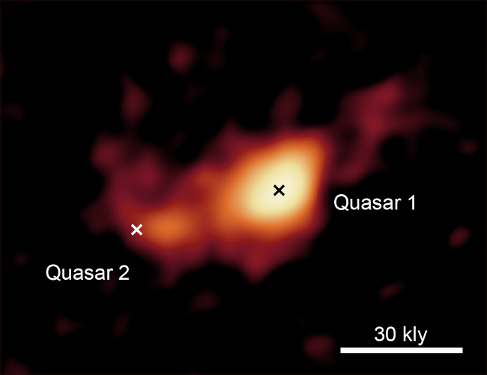
The interacting galaxies observed by the ALMA radio telescope at the Cosmic Dawn. This image shows the distribution of ionized carbon gas, which reflects the overall distribution and motion of interstellar matter. It is clearly visible that the two galaxies are interacting, and are connected by a structure between them. The two crosses in the image indicate the positions of the low-luminosity quasars discovered by the Subaru Telescope. Credit: T.Izumi et al.
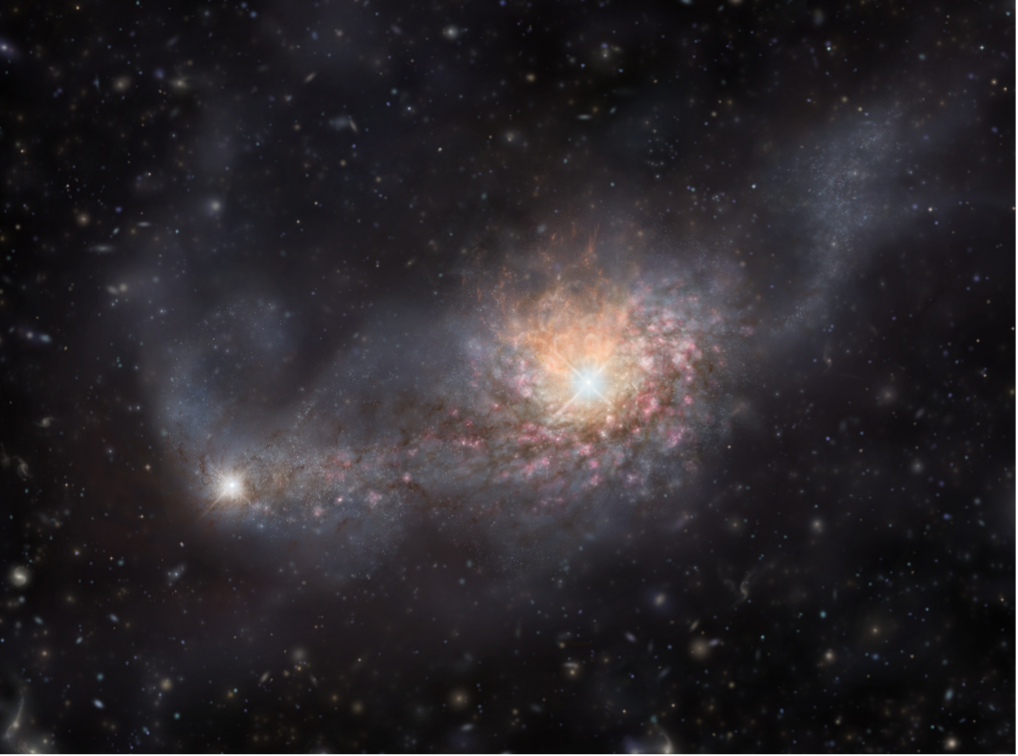
An artist’s impression of the interacting galaxies is based on the current observation results. The illustration depicts how the interaction between the galaxies gradually triggers star formation activity and the growth of the supermassive black holes at their centers.
Contacts
-
Nicolás Lira
Education and Public Outreach CoordinatorJoint ALMA Observatory, Santiago - ChilePhone: +56 2 2467 6519Cel: +56 9 9445 7726Email: [email protected] -
Yuichi Matsuda
ALMA EA-ARC Staff MemberNAOJEmail: [email protected] -
Juan Carlos Muñoz Mateos
ESO Media Officer -
Jill Malusky
Public Information Officer
